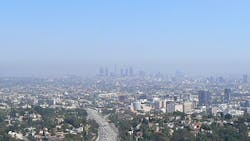EPA today strengthened its ozone standard, saying the regulatory action was needed to protect public health, particularly for at-risk groups such as children, older adults and people with lung diseases such as asthma.
The revised standard lowers the limit for ground-level ozone, a primary component of smog, to 70 parts per billion (ppb) from the 75 ppb threshold set in 2008. Ozone irritates and inflames the respiratory system, and can cause a variety of breathing problems such as shortness of breath and asthma attacks. Depending on the severity of their ozone levels, states have between 2020 and 2037 to meet the standard.
Calling the revised standard "overly burdensome, costly and misguided," Jay Timmons, president and CEO of the National Association of Manufacturers, said it will "inflict pain on companies that build things in America - and destroy job opportunities for American workers." Timmons called for Congress to act to halt implementation of the more stringent standard.
Noting that the rule could be "the most expensive regulation ever imposed on the American public," Rep. Lamar Smith, R-Texas, chairman of the House Science, Space and Technology Committee, said it would cost billions of dollars and would "most impact financially vulnerable families who already struggle to find employment and pay their bills."
But EPA said the new standard would provide a net financial gain for the nation. It estimated the public health benefits of the standard at $2.9 to $5.9 billion annually in 2025, while it pegged that annual costs at $1.4 billion. EPA added that average ozone levels had fallen 33% from 1980 to 2014 while the economy had continued to grow.
Public health groups expressed disappointment that the standard had not been lowered to 60 ppb. They had argued that a growing body of scientific evidence indicated the 60 ppb limit was needed to adequately protect the public. Michael Brune, executive director of the Sierra Club, said the Obama Administration's new rule was a "missed opportunity" and represented only a "modest step in the right direction...."
Citing EPA's estimate, Harold P. Wimmer, president and CEO of the American Lung Association, said a 60 ppb standard would have prevented 1.8 million asthma attacks in children, 1.9 million school days missed and 7,900 premature deaths.
About the Author
Steve Minter
Steve Minter, Executive Editor
Focus: Leadership, Global Economy, Energy
Call: 216-931-9281
Follow on Twitter: @SgMinterIW
An award-winning editor, Executive Editor Steve Minter covers leadership, global economic and trade issues and energy, tackling subject matter ranging from CEO profiles and leadership theories to economic trends and energy policy. As well, he supervises content development for editorial products including the magazine, IndustryWeek.com, research and information products, and conferences.
Before joining the IW staff, Steve was publisher and editorial director of Penton Media’s EHS Today, where he was instrumental in the development of the Champions of Safety and America’s Safest Companies recognition programs.
Steve received his B.A. in English from Oberlin College. He is married and has two adult children.
